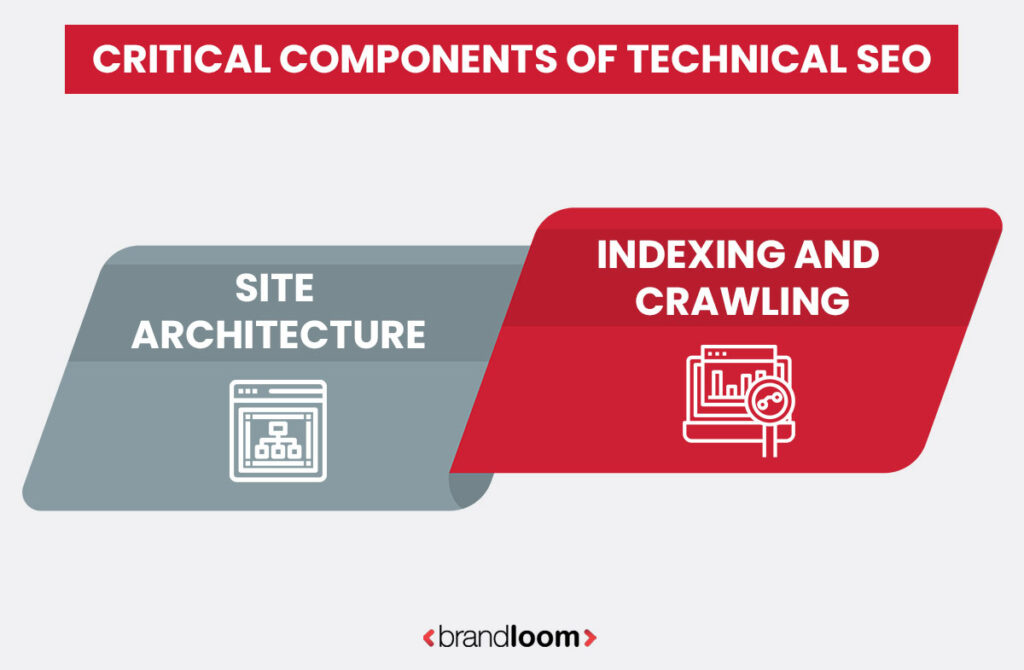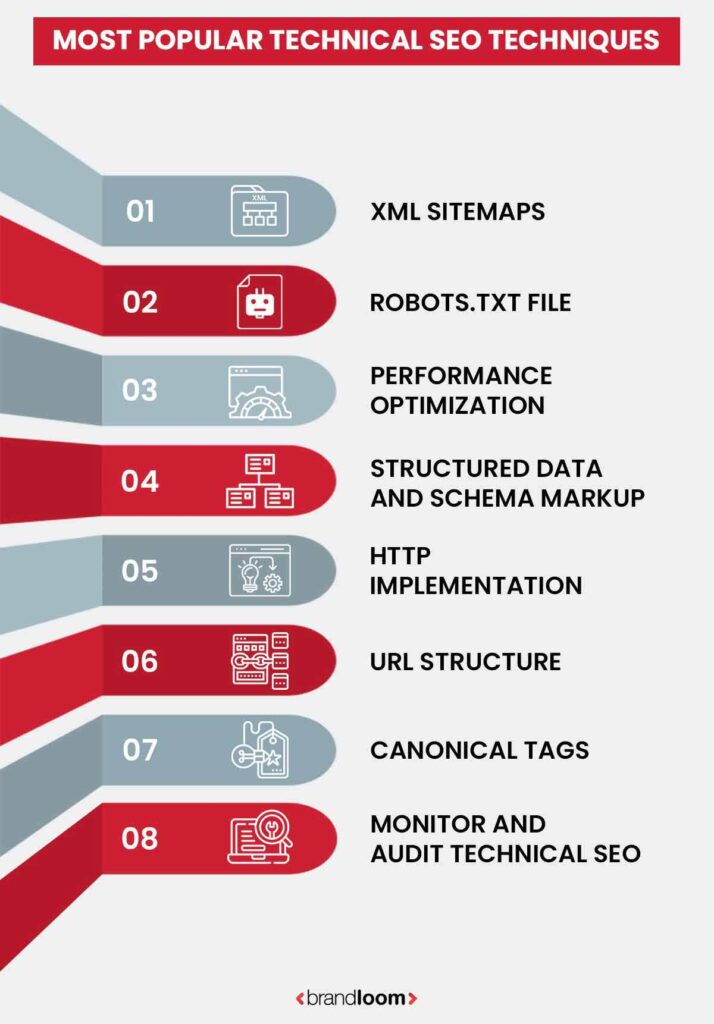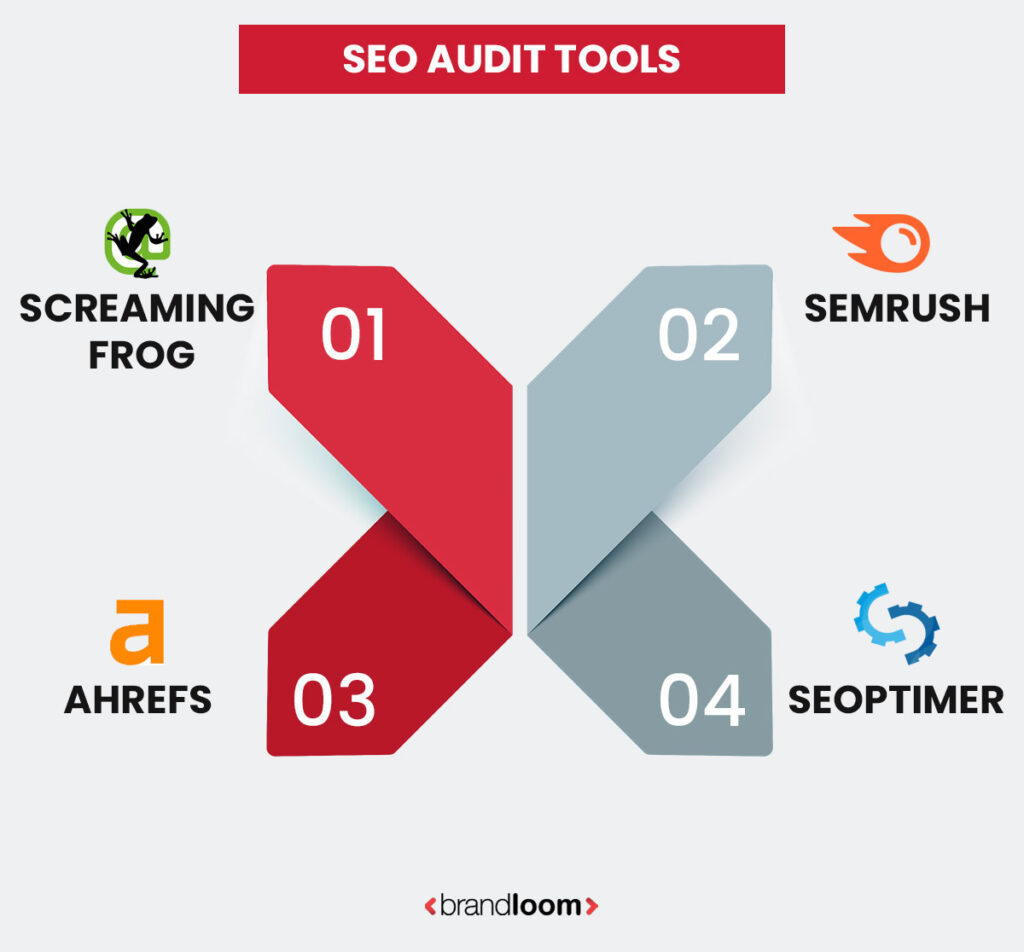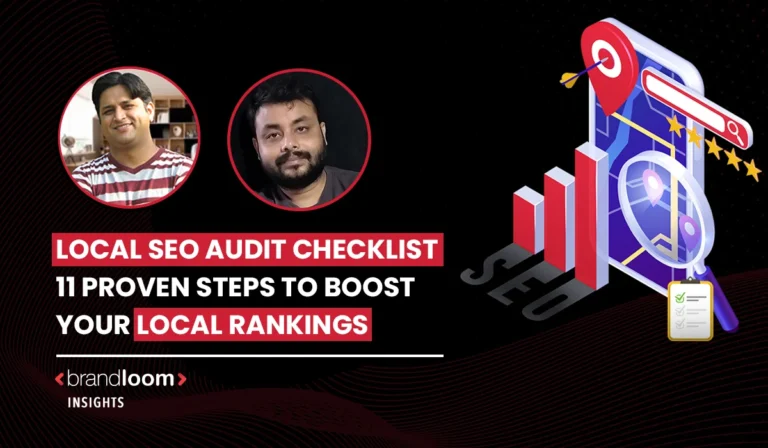You have created the website of your dreams, but instead of having people swarming to it, it sits quietly like a ghost town. Where did you go wrong? Well, one reason might be poorly incorporated technical SEO techniques.
It may load at a snail’s pace, not render well on mobiles, or glitch at multiple places, which makes for an unsatisfactory experience. In case that’s happening, there is a way out. Technical SEO can improve your website’s overall performance. Want to know how? Then fasten your seatbelt as BrandLoom gives you a sneak peek of the most popular technical SEO techniques that top developers swear by.
But first, let’s start with the basics.
What is Technical SEO?
Technical SEO refers to optimizing the infrastructure of a website so that it can improve search engine processing through more efficient crawling and indexing. It is crucial to ensure your website stays ahead of the competition and gets noticed by the target audience.
Technical SEO techniques help improve the website loading speed, resulting in a better user experience. It enables enhanced crawlability, allowing search engines to discover and index its content faster. Hence, increased visibility is another integral aspect of technical SEO techniques.
These techniques boost website security through the implementation of HTTPS. Efficient technical SEO techniques help to keep your website more responsive and structured. A responsible site boosts user engagement and minimizes bounce rates. In short, technical SEO is essential for securing your website and ensuring a more efficient outcome.
Critical Components of Technical SEO
Technical SEO is a vital step before starting your website. The key components of technical SEO, such as site architecture, crawling, and indexing, are responsible for generating desired outcomes for the website developer. Let’s have a close look at them.

1. Site Architecture
Site architecture is the main component of Technical SEO as it helps to organize the website pages more efficiently to ensure that search engines can crawl and index them well. Logical hierarchy is the crucial objective of site architecture, as the content should unfold according to the user’s expectations. Hence, the website becomes easy to navigate for both search engines and users.
Site architecture includes internal linking to increase discoverability. If pages can be accessed with a few clicks, it generates user satisfaction. Improved indexing is a crucial factor in site architecture. Descriptive URLs enable search engines to understand the website content promptly. Sitemaps also play a pivotal role in enhancing content discoverability by guiding search engines through site structure.
2. Indexing and Crawling
Your website ranking and discoverability greatly depend on the two core components of technical SEO, i.e., crawling and indexing. Crawling is an integral step where the crawlers or the search engine bots locate web pages. The crawlers follow a specific link from a known web page and land on a new page.
The XML sitemaps and internal linking structures play their respective parts in navigating the crawlers to the new page. With the help of technical SEO techniques, these pathways are optimized. The crawlers can seamlessly enter your website through these pathways and access your website content.
Indexing is another crucial aspect of making sure your website reaches its goal. After the crawling is completed, the search engine database analyzes and stores the website content. However, even if the content is crawled, indexing is not guaranteed. It depends on certain factors like content quality, meta tags, etc.
Appropriate technical SEO techniques can make the transition from crawling to indexing seamless. Efficient indexing helps boost your website ranking. BrandLoom’s web developers work hard to boost your website’s discoverability. Contact us to boost your website ranking.
How Can You Improve Technical SEO Techniques?
With digitalization coming to its full glory, it has become more important to focus on the digital aspects of brands. Brands now focus on attracting target customers through website content to maximize the marketing outcome.
Technical SEO techniques are essential for boosting website traffic and ensuring a higher website ranking, thereby providing your website with a competitive advantage over its rivals. Let’s have a look at some of the most popular technical SEO techniques that help brands meet their objectives.

1. XML Sitemaps
With XML sitemaps, search engines can discover and index website content seamlessly for a better outcome. The XML sitemaps are regarded as roadmaps that help list critical URLs and provide content per the website’s structure. The functionality of XML sitemaps revolves around boosting website visibility to the target audience.
The key benefits of XML sitemaps include higher crawl efficiency, content prioritization, structured metadata, and faster indexing. Sitemaps boost the overall crawlability of the website by allowing search engines to locate new or buried content. It optimizes the use of the crawl budget through content prioritization. It includes the critical website pages only with the most relevant content so that search engines can effectively trace it.
Additional metadata helps search engines understand the relevance of a web page. Structured data and canonical tags are helpful here. A well-configured sitemap enables faster indexing for updated or new content. Overall, an XML sitemap contributes immensely to making your website score higher in the ranking game.
2. Robots.txt File
One of the significant technical SEO techniques that can immensely benefit your website performance is the robots.txt file. It controls the way search engine crawlers interact with your website. The robots.txt file is responsible for determining which web pages or sections of the pages the crawlers can or cannot access. It helps to manage the crawl budget and content prioritization. The robots.txt file blocks non-public or duplicate pages to ensure search engines aim for only high-value content for indexing.
The integration of the sitemap directive within the robots.txt file navigates the search engines to your XML sitemap. This helps to index meaningful URLs. However, it is essential to configure this file properly; otherwise, it may lead to errors like unintentional blocking of high-value pages. BrandLoom’s web developers use these technical SEO techniques to enable you to achieve an optimum level of outcome.
3. Performance Optimization
Performance optimization is the most critical aspect of technical SEO techniques. Methods like mobile optimization and page speed are used to optimize a website’s performance. Let’s explore how BrandLoom developers maximize website performance,
Mobile Optimization
Mobile optimization aims to optimize the performance of a website for mobile users. Technical SEO techniques to optimize web content for mobile users include responsive design, page speed, structured data, and content optimization. With responsive design, it is essential to make sure that the website can adapt to different screen sizes through the use of CSS media queries and fluid grids.
Mobile users tend to face distinct challenges that are not similar to the issues faced by desktop users. Core Web Vitals (CWV), a set of specific metrics, can help to overcome these challenges and enhance user experience. Besides improving loading speed, CWV can help to ensure visual stability while boosting interactivity. Image compression, code minimization, and browser coaching leverage are used to optimize load times. Creating scannable content with clear headings and short paragraphs for website content is advisable. Images must have descriptive alt texts to ensure effective content optimization.
Page Speed
There are several technical SEO techniques for page speed to optimize website performance. Advanced caching techniques, such as server-side and browser caching, help store frequently accessed information and decrease the load times for returning website visitors.
This helps minimize server requests and enhances performance. Image compression and optimization is another technique to boost page speed. It helps to reduce the file size without compromising the quality.
Lazy loading, asynchronous loading, and code minification through the removal of unnecessary characters also help boost page speed. Deploying a Content Delivery Network is also helpful as it distributes the content across various global servers.
4. Structured Data and Schema Markup
Structured data provides a standard format to showcase page-related information and content classification. It allows search engines to understand the meaning and context of the website content so that they can present it more informally. Rich snippets in search results are responsible for enabling such an outcome for web pages. As for the schema markup, it’s a type of structured data where Schema.org defines a vocabulary so that web admins can annotate their content. They can use machine-readable tags to facilitate more proficient communication with the search engines.
Schema markup is highly preferable for boosting content visibility. JSON-LD, RDFa, and Microdata are standard schema markups. Apart from content visibility, this markup enhances the user experience by enabling better indexing. However, choosing the correct schema markup according to your content type is essential to ensure the most efficient SEO outcome.
5. HTTPS Implementation
HTTPS is meant to boost website security and user trust. It is a crucial aspect when it comes to improving the SEO ranking of your website. It has a major impact on page speed and content relevance. The websites that are secured by HTTPS will get priority during web searches over the non-secure HTTPS websites. As website security has become a key concern, the use of HTTPS has also increased. Hence, it has become integral to implement this to keep up with the algorithms and gain better search results.
HTTPS authenticated websites show a padlock sign in the address bar, allowing the users to recognize secure sites. They are more likely to visit these sites and use them for a longer time, increasing user engagement, reduced bounce rates, and increased dwell times. All these factors have a direct positive impact on the SEO rankings of the website. There are specific steps to follow to migrate to HTTPS:
- Obtainment of SSL certificate
- Website links updation
- 301 redirect setup
- Google Search Console updation
- Test and resolve mixed content.
6. URL Structure
SEO-friendly URL creation is crucial to ensure a better user experience and improve site visibility. The most important step is to incorporate relevant primary keywords in the URL. This enables search engines to analyze content’s relevance, boosting website ranking. It is advisable to keep a short URL with approximately 4 to 5 words.
As more extended and complicated URLs are difficult to remember, users can be discouraged from sharing them, affecting click-through rates and user engagement. The use of hyphens between words is mandatory for URL structure as search engines can parse such URLs effortlessly, boosting content readability.
It is best to keep URLs simple with lowercase letters and without using any special characters such as $,%,&. Use of these may lead to wrong indexing. A static URL is preferable because of its user-friendliness. A clean, simple URL enables better search results with improved SEO.
7. Canonical Tags
This is one of the most crucial technical SEO techniques at the present time. Canonical tags are responsible for signaling to search engines which version of the page is the authoritative one. These tags are helpful for preventing keyword cannibalization by indicating the original version of the content. These tags designate a single authoritative version with original content so that the search engines do not impose a penalty for having similar content on multiple pages.
Canonical tags signal to search engines which page should be considered the authoritative version. It increases the SEO ranking potential of that website. Canonical tags also help in managing syndicated content by maintaining the ranking authority by specifying the source of the content. While implementing canonical tags, several factors are to be kept in mind.
- Use of absolute URLs
- A single tag per page
- Self-referencing canonical tags
- Avoid canonical loops.
8. Monitor and Audit Technical SEO
Regular technical SEO audits are the most effective way to ensure that your site is functioning correctly. It helps to identify issues such as errors related to indexing, page speed, and crawlability. Prompt identification can reduce the chances of poor content visibility. These audits help to address the issues generated by structural modifications or new content.
Google Search Console or SEO software, like Ahrefs, crawls the website. The crawl reports must be reviewed for problems associated with duplicate content, broken links, and response codes. It is crucial to ensure that indexing is completed for all vital pages and they are included in XML sitemaps. Loading times and HTTPS should be assessed to boost user experience.
Look for the issues that directly impact the SEO performance to ensure the best technical SEO outcomes. BrandLoom developers suggest technical SEO audits on a monthly or bi-monthly basis to enable the most efficient outcome for the site.
Technical SEO Checklist You Must Follow
| Technical SEO Factor | Description |
| Website Speed & Performance | Page load time directly impacts user experience and rankings. Tools like Google PageSpeed Insights help optimize it. |
| Mobile-friendliness | Ensures the website is responsive and provides an optimal experience across all devices. |
| HTTPS Implementation | Secures your website to build trust and improve its Google rankings. |
| Crawlability | Ensures that search engine bots can effectively crawl your website. Managed using robots.txt and internal linking. |
| Indexability | Enables the search engines to detect the pages for indexing through canonical tags and meta tags (such as noindex). |
| XML Sitemap | Enables effective indexing and crawling through provision of a roadmap of the structure of the website to the search engines. |
| Robots.txt File | Specifies the pages or sections that need to be crawled by controlling the search engine crawlers. |
| Canonical Tags | Keeps duplicate content issues at bay through the indication of the preferred page version to search engines. |
| Structured Data/ Schema Markup | Enhances visibility of the page content through the use of rich snippets and allows the search engines to analyze page content. |
| Breadcrumb Navigation | Improves site hierarchy and user experience, aiding search engines in understanding page relationships. |
| URL Structure | Ensures URLs are simple, descriptive, and SEO-friendly, avoiding long, confusing strings of characters. |
| Broken Links | Identifies and fixes 404 errors to ensure a smooth user experience and maintain link equity. |
| Image Optimization | Reduces image size, uses descriptive file names, and applies alt text for better load time and accessibility. |
| Lazy Loading | Loads images and other resources only when they’re visible to the user, improving page load times. |
| Core Web Vitals | Improves UX through metrics like Largest Contentful Paint (LCP), Cumulative Layout Shift (CLS), First Input Delay (FID), etc. |
| 301/ 302 Redirects | Manages link equity when pages are moved or deleted by using appropriate redirects. |
| JavaScript SEO | Ensures that JavaScript-heavy websites are crawlable and indexable by search engines. |
| Duplicate Content Handling | Detects duplicate content through the use of 301 redirects or canonical tags. |
| Pagination | Uses tags, such as rel=”next” and rel=”prev” to make the search engines aware of paginated content. |
| Hreflang Tags | Helps search engines deliver the accurate language or a website’s regional version to the users. |
| Accelerated Mobile Pages (AMP) | Provides a fast-loading and lighter version of web pages for a better mobile view. |
| Server Response Codes | Ensures proper HTTP status codes (e.g., 200, 404, 500) are returned to search engines for accurate crawling. |
| Hosting & Server Optimization | Ensures fast, reliable servers to prevent downtime and improve overall website speed. |
What Are The Hallmarks Of A Site With Sound Technical SEO
Technical SEO is highly efficient in boosting site performance. Let us learn about the factors linked to a site with optimum technical SEO aspects.
1. Core Web Vitals 2.0 Compliance
As Google has emphasized the significance of Interaction to Next Paint (INP) and Total Blocking Time (TBT) alongside CLS and LCP, a site with these scores is high in the technical SEO. Such a website must be continuously monitored through Google PageSpeed Insights, buttons/ forms, and server response times under 200ms.
2. AI-Crawling & IndexNow Protocol Adoption
The AI-powered crawler by Google, named GeminiBot, prefers websites with structured data, clean architecture, and contextual relationships among the contents. Also, a site with IndexNow can promptly notify search engines of content updates and minimize dependency on traditional crawling schedules.
3. Mobile-Only Indexing & Accessibility Integration
As Google penalizes desktop-only websites, mobile-only indexing has become a crucial technical SEO factor along with touch optimization, mobile-responsive design, and fast load speed. With voice search becoming popular, accessibility factors have become integral to making an impact on Google’s rankings.
4. Structured Data Beyond Schema Markup
HTML5 semantic tags play a key role in improving AI-model-generated content parsing and passage ranking systems by Google. It is better to avoid content rendered by JavaScript for navigation, product listings, etc. This helps to boost crawlability, thereby increasing site reach.
5. Security & HTTPS Enforcement
The site must have updated SSL certificates and/ or TLS 1.3 to score higher in reach. At present, mixed content warnings call for ranking penalties. For instance, HTTPS pages should not have HTTP content. As HTTPS is a baseline requirement now, several hosting providers opt for free SSL certificates.
6. Content Consolidation & Redirect Management
Crawl bloat is a major concern that can be reduced through the consolidation of duplicate or outdated content. It is advisable to sunset any redirect that is older than one year. The older ones should be kept if they are getting significant traffic. Each time a page loads, the server reads each line, making the process more time-consuming and resource-intensive. Hence, a huge list of 301 redirects cannot be considered a sound technical SEO technique.
7. Technical Debt Mitigation
It is essential to pull out some of the 1% fixes, as those present an opportunity for Google to prove that your page is no longer worth indexing. You should also eliminate or take action against duplicate og: titles, tags, descriptions, meta tags, disabled old plugins, duplicate desktop and mobile navigation, duplicate tag manager installation, compliance issues for HTML and CSS, etc. All these should be thoroughly reviewed and removed for better technical SEO techniques.
8. Server-Side Rendering (SSR) & Prerendering
A site with sound technical SEO must have Server-side Rendering (SSR). This helps JavaScript-heavy sites perform well with factors like fast loading time and highly compatible AI crawlers. In addition to this, prerendering hints can be helpful for boosting perceived speed.
9. Strict Robots.txt & LLM Bot Policies
Large Language Models (LLMs) have been around for at least 2 years now. Hence, businesses must have policies in place to manage them as external search engines or use them as internal tools. They have become one of the key aspects to impact your future brand visibility. If business policies restrict the use of this content, you can block LLMs through log file analysis.
10. Modular XML/JSON Sitemaps
Technical SEO is a broad area that must be explored well to gain deeper insight. Multilingual websites with sitemaps 2.0, incorporating modular XML or JSON formats, will score high in technical SEO. Priority tagging, real-time update-related notifications, and category mapping are key factors included in this context.
Technical SEO Techniques – Tools and Resources
When it comes to website performance, Technical SEO tools and resources are important to ensure that your website performs well in the search engines. If you want to boost the SEO performance of your website, you must know about these SEO audit tools and resources.
SEO Audit tools
SEO audit tools like Screaming Frog, Ahrefs, Semrush, SEOptimer, HOTH SEO Checker, SEOmator, etc., help boost website performance. Some BrandLoom suggested tools are,
- Screaming Frog, a desktop-based tool, can crawl up to 500 URLs with its free version. It helps to find broken links and duplicate content-related issues. It can export the data to a spreadsheet to simplify the analysis part.
- Semrush is a premium suite that allows issue resolutions to be tracked. It also involves rich reporting aspects.
- Ahrefs is a popular tool that offers robust technical auditing. Additionally, it provides site structure-related insights along with actionable recommendations.
- SEOptimer includes features like a website crawler, backlink monitoring, and keyword tracking to optimize SEO performance. This tool offers a comprehensive audit that covers 100 data points with actionable recommendations.

Resources for Technical SEO
Technical SEO resources play a pivotal role in determining your website’s performance. Let’s have a look at the most popular ones.
- Google Search Console is a must-have resource if you are planning to boost the SEO performance of your site. This helps to identify indexing issues while monitoring website performance. It regularly provides data on technical issues and performance metrics to improve the website’s SEO ranking.
- Moz’s Technical SEO Checklist provides its users with a downloadable checklist covering all the major technical SEO elements of a particular website. It ensures that the site complies with the best SEO practices and enables optimum SEO outcomes.
Conclusion
With various technical SEO techniques, improving site performance through website optimization has become easier. There are ample tools and resources available in the market. These can help you improve the SEO ranking of your site. However, it is always advisable to regularly monitor your site for unwanted errors.
Lack of monitoring or audits may result in poor SEO performance despite the application of all the above-discussed technical SEO techniques. With these unbeatable techniques on technical SEO, you can also become an SEO wizard and boost your website ranking.
FAQs about Technical SEO Techniques
Technical SEO ensures that a website meets all the technical requirements associated with search engine optimization. This helps a website to rank high in search engines while boosting its visibility.
Technical SEO revolves around some critical factors like,
– Page speed
– Crawlability
– Site architecture
– Mobile friendliness
– Canonical tags
– XML sitemaps
– 404 errors
– Robots.txt files
– Secure Sockets Layer (HTTPS)
These factors work collectively to ensure excellent SEO performance of a website. Technical SEO is focused on arranging the content in a more straightforward format so that the search engines can understand it well. Then, the page can be placed according to the relevance of its content, making indexing easier.
Technical and on-page SEO are integral aspects of site performance. However, several factors differentiate them from each other, such as their focus, purpose, and key elements. Technical SEO focuses on backend structure and performance.
In contrast, on-page SEO aims to improve content quality and HTML elements. The two SEO strategies also differ in the context of purpose. The purpose of technical SEO is to improve indexability and crawlability. In the meantime, boosting user experience and relevance are vital purposes of on-page SEO.
Key elements of technical SEO are page speed, structured data, mobile friendliness, etc. In comparison, key on-page SEO elements are meta tags, internal links, keyword placement, etc. Hence, there are differences on the grounds of key components.
When it comes to site performance, it greatly depends on the website’s reach. So, how can we expand the reach of a website? The answer lies in maintaining the technical aspects of a site. SEO strategies help to align the technical aspects of the website in a way that search engines can easily understand its content.
Technical aspects such as crawlability, indexability, site performance, and site security are covered by BrandLoom’s efficient web developers to improve content visibility and SEO ranking. Crawlability and indexability help with the relevance and placement of the website in search engines, which directly impacts the traffic flow to the website. Security is an integral component as it ensures that the site gets recognized by the search consoles, prioritizing secure sites.
Technical SEO audits are highly important to boost site performance and generate a higher user experience. It helps you to improve the SEO ranking of your site by monitoring it for any technical issues. Technical site audits can involve multiple steps,
– Use tools like Ahrefs to simulate how search engines access the website
– Review the XML sitemap and the Robots.txt file to ensure the optimum level of crawlability and indexability of the page
– Review meta descriptions, title tags, header tags, etc., to efficiently manage on-page SEO
– Identify issues associated with broken links, site security, and load times to ensure proper functionality of the site.
Technical SEO techniques enable a website to perform better and emerge victorious in the highly competitive market.
Some of the key technical SEO techniques include AI overviews (AIO), Answer Engine Optimization (AEO), monitor brand presence in LLMs, topical authority, funnel-driven content, core web vitals 2.0, mobile-first indexing, structured data and schema, on-SERP optimization, brand mentions over backlinks, video content, community-driven SEO, shift to conversion metrics, keyword-centric strategies, and black-hat techniques.
With all these technical SEO aspects, you can boost your site performance. BrandLoom’s SEO experts can optimize your site with sound technical SEO techniques.
Gone are those days when new entrepreneurs had to spend sleepless nights to find ways to increase their website traffic. SEO technical tools can help you get the best results and make your website traffic skyrocket. A technical SEO strategy aims to enhance the overall performance of your website, such as increasing site speed, ensuring mobile friendliness, boosting site ranking, maintaining data security, improving crawlability, fixing technical errors, etc.
All these are focused on enhancing your website performance and reaching an audience that can transform into paying customers. The prime strategy of technical SEO remains site performance improvement through various relevant tools.
Starting off a new venture is not an easy task, especially in this digital era. If you are not aware of the technical aspects, you may lose your potential clients to some other technically sound competitors. Search engine optimization, or SEO, is one of the integral aspects to enhance the overall performance of your website.
Key technical SEO factors include website architecture, page speed, and user experience, structured data/ schema markup, HTTPS, Robots.txt files, canonical tags, etc. The primary objective of technical SEO techniques is to enhance page ranking on search engine results pages. BrandLoom, one of the best SEO service providers in India, takes care of all these aspects for you.
The key SEO techniques include intent-based keyword search, on-page optimization, technical SEO techniques, AI and personalization, high-quality backlinks, content depth and structure, funnel-driven content allocation, user experience focus, etc. It is important to understand user intent to create relevant content that ranks well.
On-page optimization aims to boost user experience and conversion rates through meta descriptions, title tags, content structure, and headers. Technical SEO techniques focus on improving website speed, mobile-responsiveness, crawlability, etc. It revolves around XML sitemaps, HTTPS, structured data/ schema markup, and page URL structure. At times, it uses artificial intelligence to understand user intent and accordingly customize the content.
Technical SEO aims to enhance a site’s backend infrastructure and ensure it shows high crawlability, indexability, and ranks well on the SERPs. On-page SEO aims to optimize the content and HTML elements on individual pages. Key elements of technical SEO are site speed optimization, mobile-responsive design, secure connections, Robots.txt files, XML sitemaps management, structured data, crawl errors, and broken link fixation.
Key on-page SEO elements involve user-intent-based keyword search, meta titles and description, header tags, image optimization, relevant content, and internal linking structure. Technical SEO focuses on boosting page visibility and user experience. In the meantime, on-page SEO focuses on improving page rankings and click-through rates.
While one cannot dismiss the importance of technical SEO techniques in boosting page performance, the difficulty level is a matter of debate. It can be difficult for beginners, while experienced SEO experts can carry it out effortlessly.
The challenges can come due to the technical nature and complex factors like mobile-friendly design, site speed optimization, structured data, HTTPS security, crawl errors fixation, etc. However, right tools and guides can reduce the challenges faced by the beginners. Therefore, it is important to break down the tasks to make it more manageable and optimize site for better results.
Technical SEO is a combination of codes and non-coding tasks. While basic technical SEO techniques does not require coding, it becomes important as you keep moving towards the advanced level tasks. Coding is integral for specific tasks like HTML/CSS adjustments, structured data implementation, redirect management, JavaScript optimization, core web vitals fixation, etc.
There are emerging trends that require a combination of both coding and non-coding expertise, such as AI-driven crawling, accessibility compliance, and performance enhancements. Tools like CMS plugins and structured data generators reduce dependency on coding practices. BrandLoom developers aim to boost your website speed and performance through well-integrated technical SEO techniques that combine both coding and non-coding tasks.





